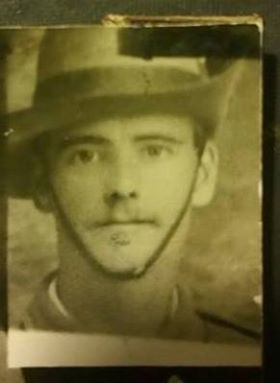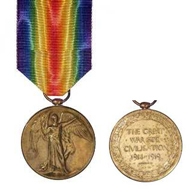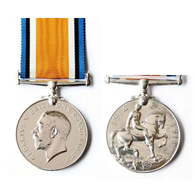HERSOM John William
-

- 3825
- Private
- 31 Battalion
- 8th Light Trench Mortar Battery, 8th Brigade
- Beerburrum Soldier Settlement
- Yes
- May 1884
- Leytonstone, Essex, England
- 22 February 1916
- HMAT A49 Seang Choon
- 19 September 1916
- Brisbane
-
Family
Samuel Hersom married Julia Cole in England in about 1881. They had twelve children, nine of whom survived to the Census date in April 1911. Their children included John William (1884-1928), Leonard (1886-1979), Annie (1889-1957), Walter James (1892-1935), George Henry (1898-1977), Frederick (1901-1979), Samuel (1903-1994), Francis Herbert (1904-1994), and Florence Elizabeth (1908-1998).
In the Census for England and Wales in April 1901, the family were recorded at 14 Albert Terrace, Leytonstone, Essex. Samuel’s occupation was head of house. John’s occupation was “house painter”.
John Hersom married Mary Louisa Simpkins at St John’s Baptist church, Leytonstone, Essex on 1 May 1904. Parents of the marrying couple were Samuel Hersom and John William Simpkins.
In the Census for England and Wales of 1911, Samuel (60) and Julia (46) were recorded at 20 Trinity St., Leytonstone. Their children at the same address were Leonard (25), Annie (22), Walter (18), George (13), Frederick (16), Samuel (8), Francis (6), and Florence (3).
All but Annie of the family migrated to Australia. Samuel and Julia and five of their children departed London aboard the “Limerick” and arrived at Brisbane on 4 June 1914. The older boys John, Walter and Leonard also made their way to Queensland.
Military context
The 31st Battalion was raised as part of the 8th Brigade at Enoggera in August 1915 and, after uniting with companies raised in Victoria and training at Broadmeadows, steamed from Melbourne in November.
The 8th Brigade joined the newly raised 5th Australian Division in Egypt and proceeded to France in June 1916. The 31st fought its first major battle at Fromelles, having entered the front-line trenches only three days earlier. Although it still spent periods in the front line, the 31st played no major offensive role for the rest of 1916.
When the German Army withdrew to the Hindenburg Line in early 1917 and the British front advanced in their wake, the 31st Battalion participated in follow-up operations but missed the heavy fighting to breach the Line at Bullecourt because the 8th Brigade was deployed to protect the Division’s flank. The only large battle in 1917 involving the 31st in a major role was Polygon Wood, fought in the Ypres sector of Belgium on 26 September.
With the 5th Division kept largely in reserve, the 31st Battalion had a relatively quiet time until the battle of Amiens on 8 August 1918. Its last major action was in September when the 5th and 2nd Australian Divisions attacked the Hindenburg Line along the length of the 6 kilometre St Quentin Canal tunnel which was a major obstacle in the German defensive scheme.
It was resting and retraining out of the line when Armistice was declared. The 31st Battalion disbanded in France on 21 March 1919.
Enlistment
John William Hersom enlisted in the A.I.F. at Cairns on 22 February 1916. At enlistment, he was a “painter”. He declared his age as 31 years 9 months and birthplace as Essex, England. He was 5 feet 7 ½ inches in height, 140 pounds in weight, of fair complexion, with hazel eyes and brown hair. No religion was stated. He listed his wife Mary Louisa Hersom of Severn St., Cairns as his next of kin (in August 1918, Mary advised Base Records of her change of address to Agnes St., Morningside, South Brisbane).
John Hersom was given regimental service number 3825. He trained with the 11th Depot Battalion and then, until 12 June, with the Reserve Company. On 12 June, he was sent to Corporals’ School. He returned to the 9th Reinforcements of 31st Battalion on 13 July. He was formally assigned on 29 August 1916 at Thompson’s Paddock, Enoggera.
Military Service
On 19 September 1916, Private Hersom embarked at Brisbane on HMAT A49 “Seang Choon”. He disembarked at Plymouth on 9 December and was marched in to the 8th Training Battalion at Larkhill, Wiltshire on 11 December.
On 16 January 1917, he proceeded to Folkestone where he embarked on “Princess Victoria” for France. He marched in to the 5th Australian Division Base Depot at Etaples on 17 January. He was taken on strength of 31st Battalion in the field on 23 January. It was midwinter and, thereafter, his war would be characterised by almost continual ill-health.
On 31 January 1917, he reported suffering from bronchial catarrh. He was admitted to 45th Casualty Clearing Station at Edgehill (Dernancourt) on 4 February and then by No.4 Train to the 10th General Hospital at Rouen on 7 February. It was not until 13 March that he marched out to the 5th Australian Division Base Depot at Etaples. He re-joined his unit ten days later.
On 2 April 1917, he was again sick to hospital. The condition was subsequently diagnosed “neurasthenia”. The term was originally used as early as 1829 to describe an actual mechanical weakness of the nerves and was a common diagnosis in World War 1. Within a decade, it was effectively abandoned as a medical diagnosis. The term “shell shock” took common, if imprecise, usage. Private Hersom marched out to the 5th Division Base Depot on 14 May, but he did not re-join his unit until 22 June.
On 7 July 1917, Private Hersom presented sick to 8th Field Ambulance with pharyngitis. He was admitted to 56th Casualty Clearing Station at Gezaincourt but then transferred by Ambulance Train to 1st Australian General Hospital in Rouen where he was admitted on 9 July. He subsequently was transferred to 11th Convalescent Depot at Buchy on 25 July. He marched out to the 5th Division Base Depot at Le Havre from hospital on 21 August, and re-joined his unit on 1 September.
On 20 September 1917, he was attached to the 8th Light Trench Mortar Battery, 8th Infantry Brigade, but six days later he again presented sick to 8th Field Ambulance. He was transferred to 3rd Casualty Clearing Station at Grevillers. His condition was again diagnosed as “neurasthenia”. On 1 October, he was admitted to 56th General Hospital and on 3 October to 26th General Hospital, both at Etaples. On 11 October, he was moved to 6th Convalescent Depot and, on 13 December, to 5th Convalescent Depot, both at Etaples. He did not re-join his unit in the field until 25 February 1918.
On 11 March 1918, he proceeded to England on UK leave. He returned to 31st Battalion in the field on 29 March.
On 9 August 1918, he presented sick to 12th Casualty Clearing Station at Longpre. His condition was diagnosed as “hyperthyroidism”. He was transported by Ambulance Train to 1st South African General Hospital at Abbeville where he was admitted on 12 August. Three days later, he was invalided to the United Kingdom on “Jan Breydel” and on, 17 August, was admitted to 1st Birmingham War Hospital (Rednal) suffering from “trench fever”. Chief symptoms were headache, skin rash, inflamed eyes and leg pain. In 1918, the root cause of the condition was found to be excretions from lice. Sufferers typically recovered after several days but much longer episodes necessitating hospitalisation were not uncommon.
On 2 September 1918, Private Hersom transferred to 3rd Auxiliary Hospital, Dartford. On 21 September, he was discharged to No.2 Command Depot, Weymouth. He had been designated for return to Australia.
On 20 October 1918, Private Hersom departed England on D28 “Borda” suffering from shell concussion. He disembarked at Sydney on 19 December 1918. He was discharged from the A.I.F. at Brisbane on 27 February 1919.
After the War
John Hersom was issued the British War Medal and the Victory Medal.
The occupation of “painter” was a consistent thread through the Hersom family. In the Queensland Electoral Roll of 1925, John and Mary Hersom were recorded at Stradbrook St., Manly, Brisbane. John’s occupation was “painter”. In the same Roll, John’s father and John’s brother Samuel, both painters, were living at Kitchener St., Manly. Another brother, Leonard, also a painter, and his wife Florence lived at Ocean Terrace, Manly. Another brother, George, also a painter, and his wife Laura lived at Ernest St., Manly. Frederick was the exception. He too lived at Kitchener Street but his occupation was “labourer”.
John William Hersom’s war service was be-devilled by illness and he would survive the new peace for fewer than ten years. He died, aged 44 years, at Stradbroke St., Manly, Brisbane on 10 October 1928 and was buried in Balmoral Cemetery (also known as Bulimba) next day. Causes of death were pennicious anaemia and subacute combined degeneration of the spinal cord.
The ages of the Hersom family at the date of their father's death were John James (23), William Ernest Pulsford (20) and Frances Mary (14).
John James Simpkins Hersom married Vera Maude Paulsen in Queensland on 16 February 1932.
William married Rose Hoy at Wynnum Baptist Church on 31 July 1937.
Frances married her brother-in-law Henry William Paulsen on 17 October 1936.
In the Electoral Roll of 1936, John's widow was recorded at Stradbrook St., Manly.
John’s father, Samuel, aged 87 years, died at Blackwood St., Manly on 13 September 1936 and was buried next day in Hemmant cemetery.
John’s mother, Julia, aged 80 years, died at Mackenzie St., Wynnum Central on 30 October 1945 and she was buried on 1 November in the same grave as her husband in Hemmant Cemetery.
John’s widow, Mary Louisa, aged 73 years, died on 8 May 1959 and was buried next day in the same grave as her husband at Balmoral Cemetery.
-
- Amiens
- Western Front
-

-

- Returned to Australia
- Disembarked "Borda" on 19th December 1918 at Sydney
- 10 October 1928
- Brisbane, Queensland
- 44 years
- Bulimba cemetery, Brisbane on 11 October 1928
-
Australian War Memorial
National Australia Archives
Ancestry.com
Trove digitised newspapers
Queensland Death Certificate 1928 / 5904 - Grant Thorne
